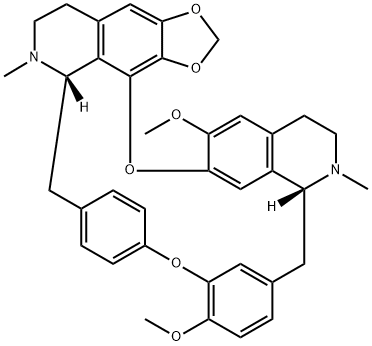PRODUCT Properties
| Melting point: | 145-155° |
| alpha | D20 +277° (c = 2 in chloroform) |
| Boiling point: | 654.03°C (rough estimate) |
| Density | 1.1761 (rough estimate) |
| refractive index | 1.5300 (estimate) |
| storage temp. | under inert gas (nitrogen or Argon) at 2-8°C |
| solubility | Soluble in DMSO (35 mg/mL) or ethanol (20 mg/mL) |
| form | solid |
| pka | 7.61±0.20(Predicted) |
| color | Pale yellow |
| Stability: | Stable for 2 years from date of purchase as supplied. Solutions in DMSO may be stored at -20°C for up to 2 months. |
| InChIKey | YVPXVXANRNDGTA-WDYNHAJCSA-N |
| SMILES | C1CC2C=C3OCOC3=C3OC4C(OC)=CC5CCN(C)[C@]([H])(CC6=CC(=C(OC)C=C6)OC6C=CC(C[C@@]([H])(C=23)N1C)=CC=6)C=5C=4 |
Description and Uses
Cepharanthine is diclofenac quinoline alkaloid isolated from rhizome of Stephania japonica, which was first recorded in “Bencao shiyi” and functions as clearing heat, promoting diuresis and detumescence in traditional Chinese medicine. Cepharanthine is a pure and natural extract of the Stephania cepharantha Hayata plant, a rare species that is native to Kotosho Island, southeast of Taiwan. In 1914, the renowned botanist, Bunzo Hayata reported the plant for the first time. Two decades later, Dr. Heisaburo Kondo purified its active ingredient and named it “Cepharanthine.” Stephania japonica was used to treat tuberculosis and other consumptive diseases which provided a clue for its development on lung disease.
Cepharanthine is a biscoclaurine alkaloid that has antiinflammatory, antineoplastic, hepatoprotectant, radiopropective and other biological functions. It is used to treat many acute and chronic diseases, including pit viper bites, alopecia areata, and leucopenia in radiation therapy.
Safety
| Symbol(GHS) |  GHS07 |
| Signal word | Warning |
| Hazard statements | H302 |
| Precautionary statements | P264-P270-P301+P312-P330-P501 |




